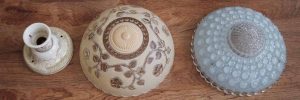By Arlene Christiansen
Read the full June 2013 issue of Viewpoints.
For all the years we’ve been in the administrative office building, I have known there were many types of light fixtures stored in the attic. I decided it would be interesting not only to find out what was up there but to learn about the turn-of-the century fixtures that are (or were) still hanging in the building. That hasn’t been as easy as it sounds. I can get very close, but make no exact matches, on identification; I think most of our fixtures must be one-of-a-kind.
The fixture still hanging in the front office, where Sandy works, is ca. 1910, but it’s not actually original to the building. When we moved into these offices in 1990, some friends, former docents who had moved to Waco, brought that fixture as a gift, thinking it was the same vintage as the house. The house was actually built in 1902-03—but close enough.
The fixture that hung in the director’s office until recently (replaced by a ceiling fan) is also ca. 1900-1910. It is a very cool piece, with a cut-glass cone between the ceiling mount and the actual lamp. It also has an arrow adornment just below the chain.
Upstairs in the attic were two hand-painted Art Deco glass bowl chandeliers (also called three-chain glass shade hanging pendants), ca. 1940. These two pieces are very similar in style to those made by Muller Freres of Luneville, France. They are pressed glass with a hand-painted exterior and are made to hang from a ceramic ceiling fixture by three chains that pass through holes in the glass bowl. I doubt ours came from France, more likely the Sears & Roebuck catalog; but they look just as pretty.
I also found a swag lamp with a velvet shade that probably dates from the 1930s. The shade has been sitting on the floor in the attic for no telling how many years. The actual light fixture was hanging on a nail in another part of the attic. I put them together because the tassel on the light chain matched the piping on the shade. Allen and I dusted the shade off and put it back with the light fixture, plugged it in, and it works. Now we can’t get it out of his office—he loves it!
Another find was a ca. 1920 five-arm chandelier with candle-like bulb holders, clear glass shades, and a bronze finish. I found one very similar to it in the 1920 GE catalog that sold for $34.00; there was also one with a “Butler silver finish” that sold for $37.50.
The fixture on the ceiling fan in my office matches a fixture in the attic, probably also used on a ceiling fan. When we purchased the house, my office was two rooms, the kitchen and dining room, so it would make sense to have had two ceiling fans. I think they must date from much later, maybe the 1970s, because of the type of shades that are on them. I believe the matching fixture was in another location in my office; I wish they had left it there, because I could really use the light.
The attic is hiding some architectural artifacts, too—rosettes (corner blocks) that match the ones on the door frames in the house and spindles, like the ones on the front porch railing.
You just never know what may be hiding in the attic. My little search has been very interesting but also sort of frustrating. Maybe if I keep looking someday I will find out more; I guess research is a never-ending process.
[share title=”love it, share it!” socials=”facebook, twitter, google, pinterest, bookmark” ]


 Teaching Sustainable Living to the Next Generation
Teaching Sustainable Living to the Next Generation